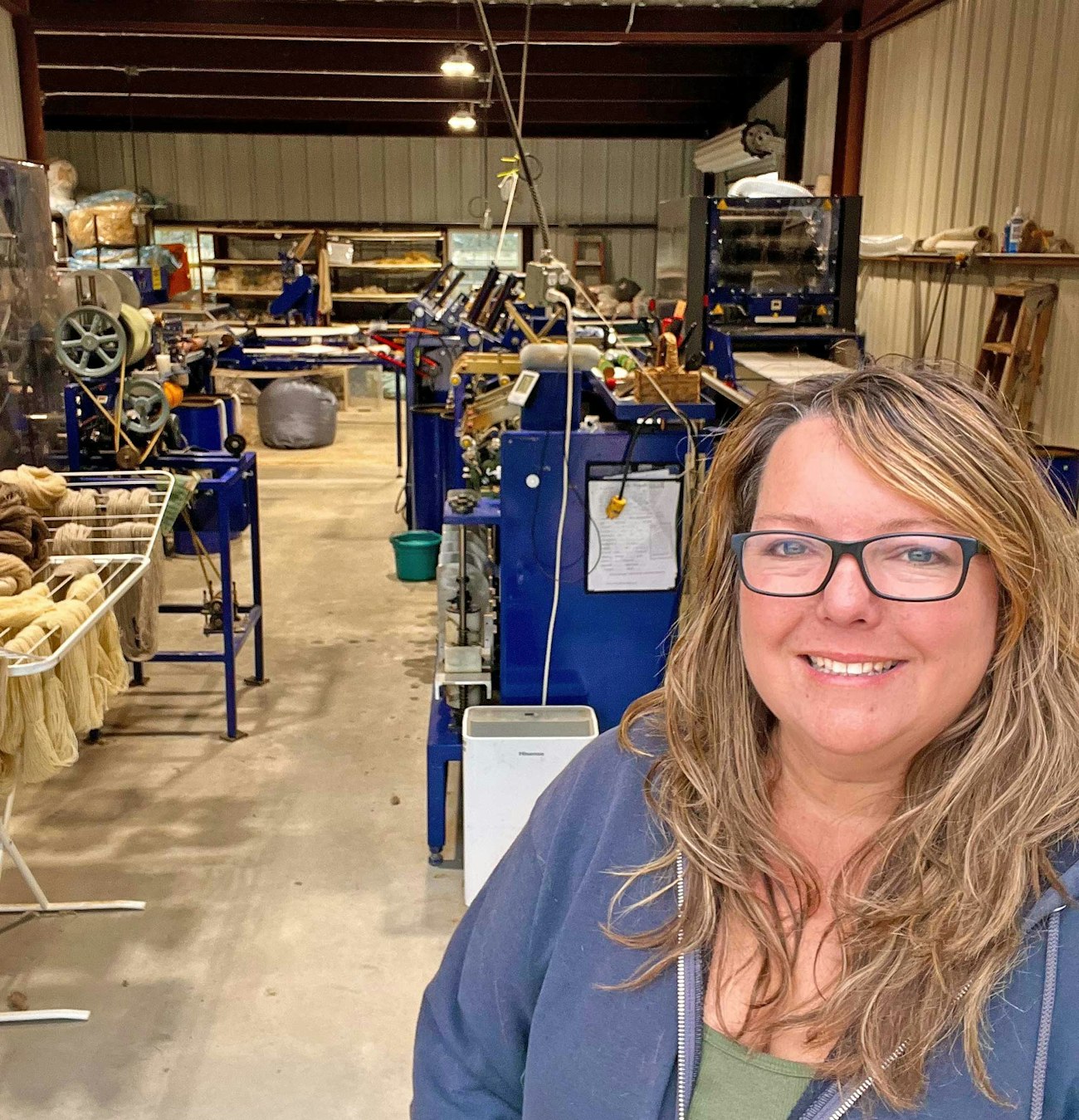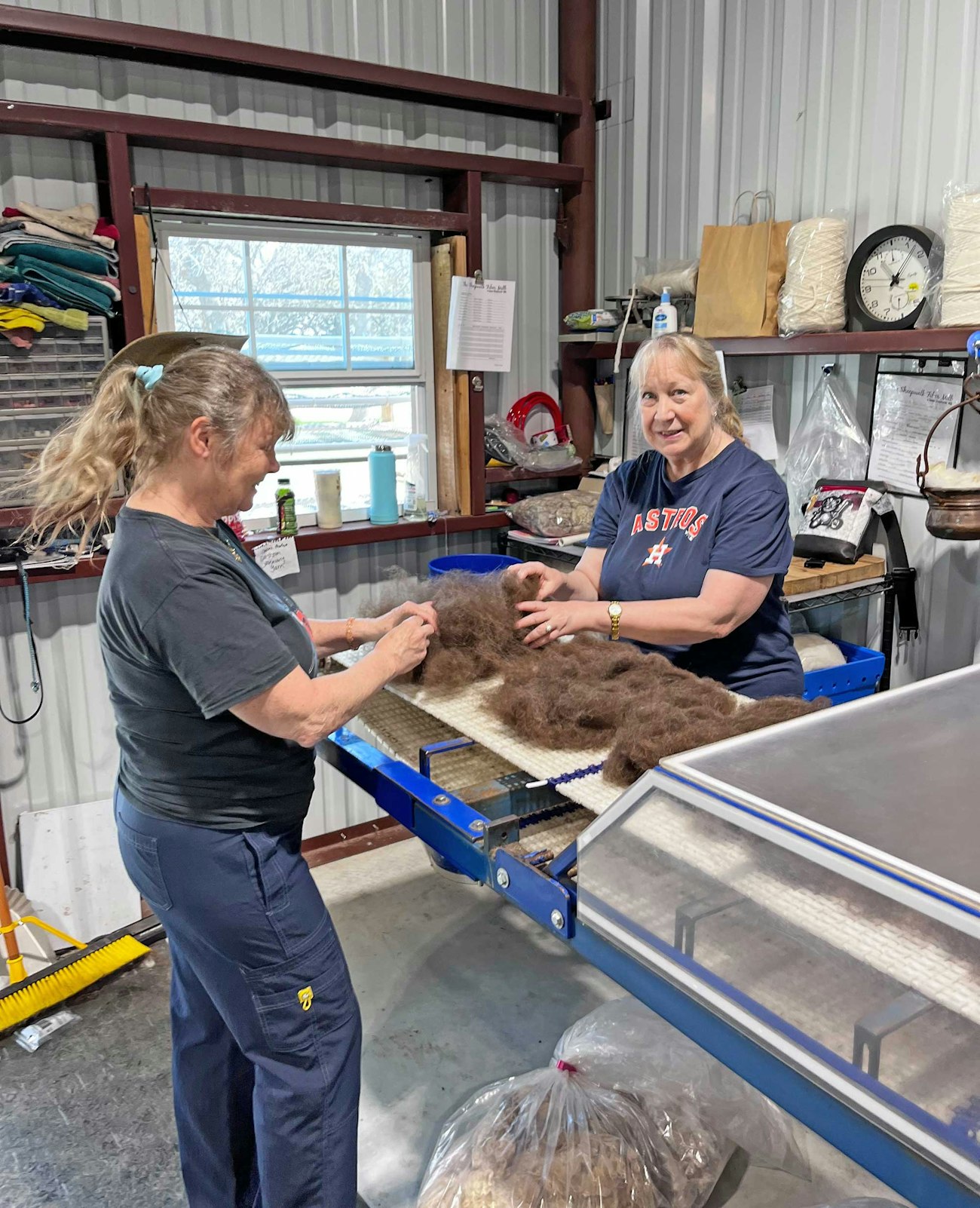At The Sheepwalk Ranch and Fiber Mill in the beautiful Texas Hill Country, Jennifer Nimmrichter specializes in raising a mix of heritage sheep breeds and crosses that provide unique wool. What once started out as a yarn shop and indie-dyed yarn business morphed into a sheep ranch with a full fiber mill.
Jennifer states, “This is never just about me. It’s always about WE.” And she's working on many fronts, including as a participant in an EU (European Union) initiative to keep wool relevant through discussion of fiber arts, wool production, and more. “I personally am very excited to be a part of this larger community because it helps us to tell the story of Texas.” Back at home, Jennifer works to process wool from her own flock, as well as from those around the state and beyond.
We asked Jennifer to tell us more about the breeds she raises, the yarn she sells, and the woolly connections she’s working to form around the globe.
Farm & Fiber Knits: Tell us about your mix of heritage breeds and the crosses you raise. What makes the wool unique?
Sheepwalk Ranch: We have a mix of heritage and standard breeds of wool sheep—25 breeds in all, ranging from those that produce rug wool to fine wool. We have 18 pure wool breeds and seven crossed wool breeds. Our cross breeds are the most fascinating because they help me understand the pure wool breeds better.
Click on any image below to open it in full-screen mode and learn more about some of the breeds at The Sheepwalk Ranch.
The Rambouillet, for instance, can be linked back to the first bloodlines brought to Texas in the early 1800s. More commonly white, they can have colored fleeces, which are considered undesirable at the industrial level—but prairie gold at the artisan level. Our Suffolks are an experiment in focusing on wool quality first versus meat quality. Suffolk, a Down breed, had its start in the 1700s as a cross between a more ancient breed, the Norfolk Horn, and the Southdown. Today’s Suffolk is mainly raised for meat, and their white fleece is largely considered “trash wool” and barely draws 10 cents a pound. Down breed wool doesn’t felt or full at the same rate as other wool types, making this an ideal wool for a sock yarn blend, for instance. We breed our Suffolk ewes every other year with Leicester Longwool rams. A Down crossed with a Leicester is the foundation cross for many breeds worldwide, including the Galway sheep from Ireland.
Galway wool, like our Suffolk-cross, can range from sweater knitting to rug weaving. Our rug-wool breeds, such as Karakul, represent the migration and settlement of cultures. These sheep can be found in areas ranging from India to the Aegean Sea. We call them our floppy ear sheep because if you look up rug-wool breeds, you will see this trait is pretty strong. While the wool and breed name may vary due to environment and selective breeding, the texture and purpose remains the same—sturdy textiles. In 2025, we will be stepping outside of the U.S. to attend Wool School in Greece, where we hope to learn more about these special sheep breeds.
Click on any image below to open it in full-screen mode and learn more about the yarns.
FFK: You’re working to expand the artisan mill you run. Tell us more.
SR: The mill expansion allows me to have time to process the wools we raise so that I can create an educational space to talk wool quality and farming. We can explore why there is so much variation in the wool of one breed versus consistency among another. The expansion means we can open the doors for internships, for the business of wool as a trade, and to help our current producers get a better look at their farming practices based on what we experience in wool quality at the processing level.
 Jennifer is shown here with the new mill equipment at the Sheepwalk Ranch and Fiber Mill. She was raised with a love of agriculture at an early age and has found that working with machines and innovation is her thing.
Jennifer is shown here with the new mill equipment at the Sheepwalk Ranch and Fiber Mill. She was raised with a love of agriculture at an early age and has found that working with machines and innovation is her thing.
FFK: How did the annual event called the Texas Wool Week begin?
SR: I am the founder of Texas Wool Week, a fiber and arts retreat hosted on our property, and have been working to develop this event since 2014. We started it as a small retreat week for friends. Texas Wool Week is now a working farm experience with fiber and arts vendors, musical entertainment, day-trip adventures during the week, shearing days, and more. It represents years of collaboration, research, and personal field work as a rancher of wool sheep and purveyor of wool goods. Texas Wool Week is designed to make what we do and love an adventure for all and we'll celebrate the 10th annual event in 2025.
 Texas Wool Week—Day at The Mill: As part of their commitment to teaching about hand processing versus mill processing, The Sheepwalk Ranch opens their doors annually—if not monthly—to fiber artists who want that hands-on experience. This is usually offered during the first part of Wool Week so that their guests can dive in to the arts classes.
Texas Wool Week—Day at The Mill: As part of their commitment to teaching about hand processing versus mill processing, The Sheepwalk Ranch opens their doors annually—if not monthly—to fiber artists who want that hands-on experience. This is usually offered during the first part of Wool Week so that their guests can dive in to the arts classes.
FFK: How did Galway wool lead to your involvement with the EU initiative on wool innovation and tradition?
SR: A month or so ago, I was asked to be part of an EU initiative as a potential consultant. We felt that my connections to the wider community was enough to bring some insight to the EU community. The initiative explores the needs of the wider community, from wool farmer to fiber artist to breed preservation. None of this would have happened if I had not chased down Blátnaid Gallagher, cofounder and spokesperson for the Galway Wool Co-Op, in November 2023 while visiting Ireland. I wanted to talk to someone in Ireland about cooperatives and how they handle bringing farmers together. From that first meeting, I brought home a fleece.
In July 2024, I returned to Ireland to be an honorary judge at the Galway Co-Op gathering, fleece sale, and mini festival. This gave me a chance to dive into bags of fleece and really study the fiber. I committed to 440 pounds (200 kilos) of Galway wool to help develop product and to be an ambassador of Galway wool. We purchased the 200 kilos of wool and brought it home to process at our fiber mill.
Again, the cultural significance of this ambassadorship helps me tell the story of wool. In the Summer of 2025, I will head overseas to start connecting the dots by traveling to Greece, Iceland, and Ireland to meet more members of the EU initiative.
 For Jennifer, sampling is key to knowing if they hit the mark on a product. Left: The woven swatch is for a 2-ply 100% Navajo Churro warp. The hairs were a concern but seem to not be affecting the sample tapestry piece. Right: Jennifer points out that farm blends can be tricky. What looks interesting as a cloud can spin up nicely or become rug yarn. This farm blend is Leicester Longwool, Suffolk Longwool cross, primitive Shetland, and Finn.
For Jennifer, sampling is key to knowing if they hit the mark on a product. Left: The woven swatch is for a 2-ply 100% Navajo Churro warp. The hairs were a concern but seem to not be affecting the sample tapestry piece. Right: Jennifer points out that farm blends can be tricky. What looks interesting as a cloud can spin up nicely or become rug yarn. This farm blend is Leicester Longwool, Suffolk Longwool cross, primitive Shetland, and Finn.
FFK: The Galway yarn looks so shiny and plump—what is it like to knit?
SR: Galway wool has the luster of its Longwool ancestors and springing crimp of its Down ancestors. Knitting is easy as each stitch balances out the next. We chose a semi-worsted spin higher twist in the ply, knowing it would settle through wear and tear of daily use. Like any heritage breed, each Galway fleece has its own story to tell.
Find The Sheepwalk Ranch and Fiber Mill on the web at thesheepwalkranch.com or on social media:
Instagram: @thesheepwalkranch and @followthesheepwalk
Facebook: The Sheepwalk Ranch









